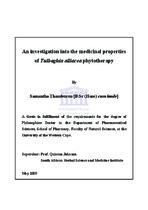| dc.description.abstract | The reproductive health of individuals is severely compromised by HIV infection, with candidiasis being the most prevalent oral complication in patients. Although not usually associated with severe morbidity, oropharyngeal candidiasis can be clinically significant, as it can interfere with the administration of medications and adequate nutritional intake, and may spread to the esophagus. Azole antifungal agents are commonly prescribed for the treatment and prophylaxis of candidal infections. However, the emergence of drug resistant strains and dose limiting toxic effects have complicated the treatment of candidiasis. Consequently, safe and effective and affordable medicine is required to combat this fungus. Commercial garlic (Allium sativum) has been used time since immemorial as a natural antibiotic, however very little is known about the antifungal properties of two indigenous South African species of garlic, namely Tulbaghia alliacea and Tulbaghia violacea, that are used as folk medicines for a variety of infections. This study compares the in vitro anti-candidal activity of Tulbaghia alliacea, Tulbaghia violacea and Allium sativum extracts. It was found that the greatest concentrations of inhibitory components were extracted by chloroform or water. The IC50 concentrations of Tulbaghia alliacea were between 0.007 - 0.038% (w/v). Assays using S. cerevisiae revealed that the T. alliacea extract was fungicidal, with a killing half-life of approximately 2 hours. This inhibitory effect of the T. alliacea extracts was observed via TLC, and may be due to an active compound called Marasmicin, that was identified using NMR. This investigation confirms that extracts of T.alliacea exhibit anti-infective activity against candida species in vitro. | en_US |

